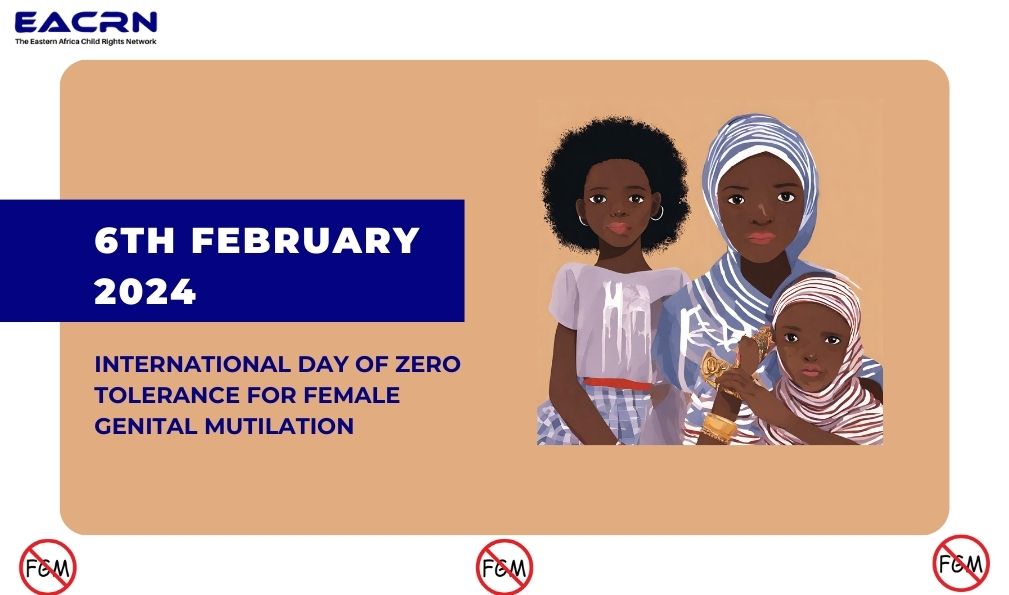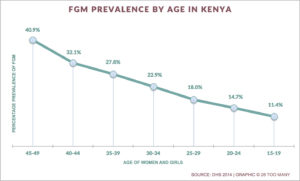Overview of FGM
Female genital mutilation, also known as female genital cutting or female circumcision, is the practice of modifying or removing sections of the female genitalia for non-medical purposes and is recognized internationally as a violation of human rights, the health and the integrity of girls and women. According to the United Nations, more than 200 million girls and women alive today have undergone female genital mutilation (FGM) in 30 countries in Africa, the Middle East and Asia where FGM is practiced. One in five girls in Kenya has undergone female genital mutilation (FGM).
Girls who undergo female genital mutilation face short-term complications such as severe pain, shock, excessive bleeding, infections, and difficulty in passing urine, as well as long-term consequences for their sexual and reproductive health and mental health
Hotspots of FGM in Kenya
Prevalence varies greatly depending on the region; the (former) province with the highest prevalence is North Eastern (97.5% of women aged 15–49), and the province with the lowest is Western (0.8%). Prevalence is more common among women who live in rural areas, at 25.9%, than among women who live in urban areas, at 13.8%.
FGM/C is practiced across all ethnic groups and religions, although to varying degrees. The highest prevalences are among Muslim women (51.1% of women aged 15–49) and Somali women (93.6%); the lowest prevalence according to religion is among Protestant/other Christians (17.9%); and the lowest according to ethnic group appears to be among the Luhya (0.4%) and Luo (0.2%), although the small numbers of women who had been cut in each of these sample groups may make the statistics unreliable. According to a 2014 documentary, The Elite Also Cut (Kenya CitizenTV), there is a lack of comprehensive data on FGM/C among the Kuria, but prevalence is thought to be very high.
92.5% of women aged 15–49 and 88.8% of men in the same age-range believe that FGM/C should not be continued (https://www.fgmcri.org/country/kenya/)
Types of FGM
Female genital mutilation is classified into four major types:
Type 1: This is the partial or total removal of the clitoral glans (the external and visible part of the clitoris, which is a sensitive part of the female genitals) and/or the prepuce/clitoral hood (the fold of skin surrounding the clitoral glans).
Type 2: This is the partial or total removal of the clitoral glans and the labia minora (the inner folds of the vulva), with or without removal of the labia majora (the outer folds of the skin of the vulva).
Type 3: Also known as infibulation, this is the narrowing of the vaginal opening through the creation of a covering seal. The seal is formed by cutting and repositioning the labia minora, or labia majora, sometimes through stitching, with or without removal of the clitoral prepuce/clitoral hood and glans.
Type 4: This includes all other harmful procedures to the female genitalia for non-medical purposes, e.g., pricking, piercing, incising, scraping and cauterizing the genital area.
Ending FGM by 2030
Over the last three decades, the prevalence of FGM has declined globally. Today, a girl is one-third less likely to undergo FGM than 30 years ago. The prevalence of FGM/C in Kenya has dropped from 37.6% of women aged 15–49 in 1998 to 21% in 2014 to 14.8 in 2021. Due to the large age-range of women included, however, the overall prevalence alone may not fully reflect the progress that has been made in recent years. Breaking down the most recent data by age group shows that the prevalence for women aged 45–49 is 40.9%, while for the youngest age group this has fallen to 11.4%. Despite the fact that a small proportion of women may be cut after the age of 15, the data demonstrates a clear trend towards lower prevalence among younger women. The United Nations Population Fund’s annual report on female genital mutilation shows that Kenya is on the right path toward ending this cultural practice. However, challenges have been witnessed and felt during the fight to eliminate FGM in the country. In a recent incident, a police officer was stoned to death for rescuing FGM survivors.
Way forward
As we work to eliminate female genital mutilation in Kenya, Africa, and the rest of the world by 2030, it is critical that CSOs, governments, NGOs, community leaders, and other stakeholders work together to educate women, girls, men, and boys about the dangers of FGM.
Reference:
https://www.fgmcri.org/country/kenya/
https://www.who.int/news-room/fact-sheets/detail/female-genital-mutilation#:~:text=Overview,organs%20for%20non%2Dmedical%20reasons.
https://www.un.org/en/observances/female-genital-mutilation-day




